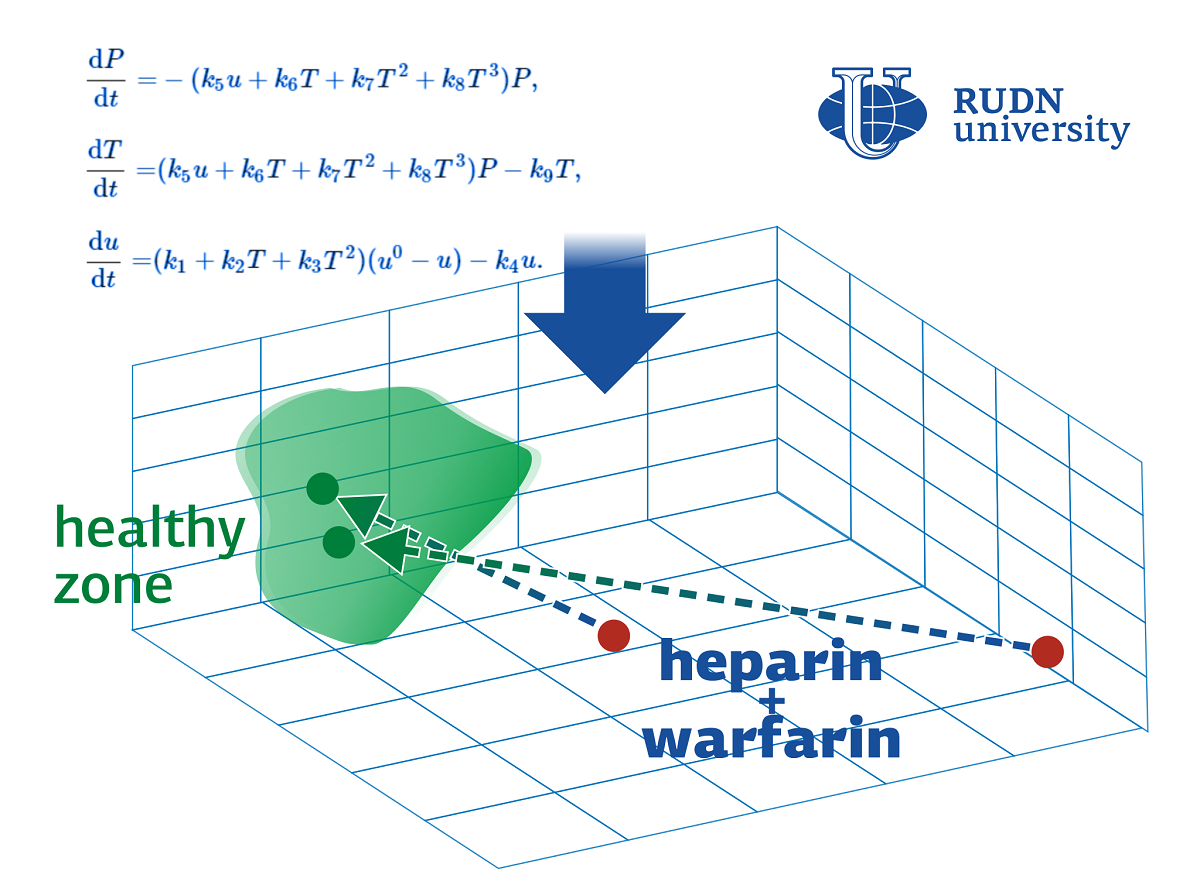RUDN University Mathematician Develops an Approach for Individual Therapy of Haemophilia and Thrombosis

Blood clotting is an important physiological process that stops bleeding when blood vessels are damaged. It is carried out due to a very complex and subtle process of regulating biochemical reactions in blood plasma and platelet aggregation. If this regulation is violated, blood clotting may be insufficient, which is observed, in particular, in haemophilia, or excessive, which can lead to thrombosis, heart attack or stroke. There are numerous works on mathematical modelling of blood clotting, but in many cases these results remain purely theoretical. For their real application in clinical medicine, it is necessary to take into account the individual characteristics of patients, which can cause certain difficulties due to the large expenditure of time and resources. The RUDN University mathematician together with colleagues from France and the USA has developed an approach that will allow determining the mathematical parameters of the system using a standard laboratory test of thrombin generation. It can help simulate blood clotting for a specific patient and choose the optimal dosages of drugs.
“The experimental and clinical data are often reduced to thrombin generation curves (thrombin concentration in time), the inverse problem for the determination of the parameters of the model becomes highly under-determined. Therefore, clinical applications of kinetic models encounter serious difficulties which are not yet completely overcome”, says Vitaly Volpert, director of the interdisciplinary research center “Mathematical modeling in Biomedicine” of RUDN University.
Mathematicians used a simple kinetic model of blood clotting, which includes only three differential equations and nine parameters. The scientists started from an available and widespread thrombin generation test, which shows how the amount of thrombin in the blood changes over time. Then the parameters are adjusted so that the model curve matches as accurately as possible with the experimental one. According to these parameters, it is possible to study the clotting model already for a specific patient and select the right treatment. As experimental data, the scientists used the results of tests of patients with haemophilia, thrombosis and with no blood coagulation disorders.
RUDN University mathematicians have found out that only a few parameters are enough to characterize the individual characteristics of patients. These are the parameters that are responsible for the action of the antithrombin, the activation of factor X by thrombin and thrombin self-activation. By them scientists can separate patients with clotting disorders from healthy patients. Taking this into account, mathematicians were able to choose protocols for individual treatment of coagulation disorders with conventional drugs heparin and warfarin. The algorithm helps to select the dosage of drugs so that the key parameters are moved to the “healthy zone”, which corresponds to the values in patients without coagulation disorders.
“We illustrated the action of warfarin on a virtual thrombotic patient characterized by the parameters of thrombin generation curves. This treatment does not bring the corresponding trajectory to the healthy zone. Similarly, treatment by heparin does not allow us to move TGC to the healthy zone. A proper combination of these drugs chosen for each individual patient modifies the corresponding TGCs in such a way that they are located in the healthy zone”, Vitaly Volpert, concludes.
The results are published in the journal Bulletin of Mathematical Biology.
RUDN summarized the results of the scientific competition "Project Start: work of the science club ". Students of the Faculty of Physics, Mathematics and Natural Sciences have created a project for a managed queuing system using a neural network to redistribute resources between 5G segments. How to increase flexibility, make the network fast and inexpensive and reach more users — tell Gebrial Ibram Esam Zekri ("Fundamental Computer Science and Information Technology", Master's degree, II course) and Ksenia Leontieva ("Applied Mathematics and Computer Science", Master's degree, I course).
The National Demographic Report, 2023 Demographic Well-Being of Russian Regions (hereinafter - the National Demographic Report) was prepared by the scientific team of the Institute of Demographic Studies of the Federal Research Center of the Russian Academy of Sciences, the Vologda Scientific Center of the Russian Academy of Sciences, Peoples' Friendship University of Russia, the Center for Family and Demography of the Academy of Sciences of the Republic of Tatarstan, as well as with the participation of leading scientists from the Republic of Bashkortostan, Stavropol Krai, Volgograd, Ivanovo, Kaliningrad, Nizhny Novgorod, Sverdlovsk Oblasts and Khanty-Mansi Autonomous Okrug–Yugra.
RUDN summarized the results of the scientific competition "Project Start: work of the science club ". Students of the Faculty of Physics, Mathematics and Natural Sciences have created a project for a managed queuing system using a neural network to redistribute resources between 5G segments. How to increase flexibility, make the network fast and inexpensive and reach more users — tell Gebrial Ibram Esam Zekri ("Fundamental Computer Science and Information Technology", Master's degree, II course) and Ksenia Leontieva ("Applied Mathematics and Computer Science", Master's degree, I course).
What is your first association with the word “laboratory”? Flasks and beakers? Microscopes and centrifuges? Yes, many of us would answer the same way.
The National Demographic Report, 2023 Demographic Well-Being of Russian Regions (hereinafter - the National Demographic Report) was prepared by the scientific team of the Institute of Demographic Studies of the Federal Research Center of the Russian Academy of Sciences, the Vologda Scientific Center of the Russian Academy of Sciences, Peoples' Friendship University of Russia, the Center for Family and Demography of the Academy of Sciences of the Republic of Tatarstan, as well as with the participation of leading scientists from the Republic of Bashkortostan, Stavropol Krai, Volgograd, Ivanovo, Kaliningrad, Nizhny Novgorod, Sverdlovsk Oblasts and Khanty-Mansi Autonomous Okrug–Yugra.